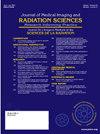Getting in Line: Impact of Indexing on Treatment Setup Accuracy for Prostate Radiotherapy
IF 2
Q3 RADIOLOGY, NUCLEAR MEDICINE & MEDICAL IMAGING
Journal of Medical Imaging and Radiation Sciences
Pub Date : 2025-05-01
DOI:10.1016/j.jmir.2025.101932
引用次数: 0
Abstract
Purpose/Aim
Patient positioning is vital to the accurate delivery of radiation therapy treatments, especially in the era of ultra-hypofractionation and stereotactic body radiotherapy (SBRT). Indexing immobilization devices improves positional consistency and may minimize setup errors. With daily onboard imaging, changes in positioning can be visualized and rectified translationally, however, rotations may not always be corrected without 6 degrees-of-freedom compliant linear accelerator beds. The purpose of this retrospective analysis is to determine whether utilizing indexing in patient positioning for prostate patients improves treatment setup in terms of rotations.
Methods/Process
Images from prostate patients treated between August 2023 to November 2023 with indexed and unindexed immobilization were reviewed. All patients were positioned using two standard pillows under head, a thin mattress, and a black leg immobilizer. Indexing was achieved using an in-house fabricated bar mounted at specific coordinates on each tabletop. The mounting position acted as an anchor to fix the leg immobilizer, allowing a reference for the distance from the inferior aspect of the leg immobilization (bottom of the foot) to the set-up mark. Patient planning CTs and cone beam CTs (CBCTs) acquired daily before treatment were restored in the radiation therapy electronic medical records and re-matched to determine the extent of rotations in all three directions from set-up. Student t-test was used to determine differences between the cohorts.
Results or Benefits/Challenges
A total of 988 CBCTs were successfully restored and rematched. The study consisted of four cohorts: Patients treated to their primary disease and pelvic nodal volumes with indexing (Indexed_Pelvis, n=330) and without indexing (Unindexed_Pelvis, n=306), and patients treated to their primary disease only with indexing (Indexed_Prostate n=200), and without indexing (Unindexed_Prostate, n=152). The maximum rotation exhibited was 4 degrees in the pitch for patients with indexed immobilization, whereas the maximum rotation for the unindexed cohorts was 5.3 degrees. The average yaw from Index_Pelvis was statistically higher than Unindexed_Pelvis (meanIndexed_Pelvis = 0.57, meanUnindexed_Pelvis = 0.38, p<0.001). The average pitch for Indexed_Pelvis was statistically lower than the average pitch for Unindexed_Pelvis (meanIndexed_Pelvis = 0.68, meanUnindexed_Pelvis = 1.29, p<0.001). No statistical differences were found for the roll exhibited by the Indexed_Pelvis and Unindexed_Pelvis cohorts. All rotations for the Indexed_Prostate group were statistically lower than the Unindexed_Prostate group (yaw: meanIndexed_Prostate = 0.32, meanUnindexed_Prostate = 0.46, p<0.001; pitch: meanIndexed_Prostate = 0.64, meanUnindexed_Prostate = 1.17, p<0.001; roll meanIndexed_Prostate = 0.37, meanUnindexed_Prostate = 1.0, p<0.001).
Conclusions/Impact
The use of a simple patient positioning device such as the black-leg immobilizer can result in setup rotations that on average were consistently <2 degrees in all directions. Use of indexing resulted in an average rotation of <1 degree in all three directions. Thus, indexing is a valuable technique that should be implemented to improve prostate patient setup especially in the era of ultra-hypofractionation, and stereotactic body radiotherapy to improve treatment accuracy.
排队:索引对前列腺放疗治疗设置准确性的影响
目的:在超低分割和立体定向体放射治疗(SBRT)时代,患者定位对放射治疗的准确递送至关重要。分度固定装置提高了位置一致性,并可以最大限度地减少设置错误。通过每日机载成像,定位变化可以可视化并平动校正,然而,如果没有6个自由度的线性加速器床,旋转可能并不总是校正的。本回顾性分析的目的是确定在前列腺患者的患者定位中使用索引是否可以改善旋转方面的治疗设置。方法/处理回顾性分析了2023年8月至11月前列腺患者的图像,这些患者采用索引固定和非索引固定。所有患者均使用两个标准枕头,薄床垫和黑色腿部固定器定位。索引是通过安装在每个桌面的特定坐标上的内部制造的杆来实现的。安装位置作为固定腿部固定器的锚点,允许参考从腿部固定器的下侧面(脚的底部)到设置标记的距离。将治疗前每日获得的患者计划ct和锥束ct (cbct)恢复到放射治疗电子病历中,并重新匹配以确定从设置开始在所有三个方向上旋转的程度。使用学生t检验来确定队列之间的差异。结果或益处/挑战共有988个cbct成功恢复并重新匹配。该研究包括四个队列:对原发疾病和盆腔淋巴结体积进行索引治疗的患者(indexed_骨盆,n=330)和未进行索引治疗的患者(unindexed_骨盆,n=306),以及仅对原发疾病进行索引治疗的患者(indexed_前列腺,n=200)和未进行索引治疗的患者(unindexed_前列腺,n=152)。索引固定患者的最大旋转为4度,而未索引的队列的最大旋转为5.3度。index_盆骨的平均偏角在统计学上高于unindexed_盆骨(meanindexed_盆骨 = 0.57,meanunindexed_盆骨 = 0.38,p<0.001)。indexed_盆的平均间距在统计上低于unindexed_盆的平均间距(meanindexed_盆 = 0.68,meanunindexed_盆 = 1.29,p<0.001)。indexed_盆骨组和unindexed_盆骨组所显示的滚动没有统计学差异。indexed_前列腺组的所有旋转均低于unindexed_前列腺组(yaw: meanindexed_前列腺 = 0.32,meanunindexed_前列腺 = 0.46,p<0.001;pitch: meanindexed_前列腺 = 0.64,meanunindexed_前列腺 = 1.17,p<0.001;滚动meanindexed_前列腺 = 0.37,meanunindexed_前列腺 = 1.0,p<0.001)。结论/影响使用一种简单的患者定位装置,如黑腿固定器,可以导致装置在各个方向上平均持续旋转2度。使用分度导致在所有三个方向上平均旋转<;1度。因此,索引是一项有价值的技术,特别是在超低分割时代,应该实施,以改善前列腺患者的设置,并提高立体定向放射治疗的准确性。
本文章由计算机程序翻译,如有差异,请以英文原文为准。
求助全文
约1分钟内获得全文
求助全文
来源期刊

Journal of Medical Imaging and Radiation Sciences
RADIOLOGY, NUCLEAR MEDICINE & MEDICAL IMAGING-
CiteScore
2.30
自引率
11.10%
发文量
231
审稿时长
53 days
期刊介绍:
Journal of Medical Imaging and Radiation Sciences is the official peer-reviewed journal of the Canadian Association of Medical Radiation Technologists. This journal is published four times a year and is circulated to approximately 11,000 medical radiation technologists, libraries and radiology departments throughout Canada, the United States and overseas. The Journal publishes articles on recent research, new technology and techniques, professional practices, technologists viewpoints as well as relevant book reviews.
 求助内容:
求助内容: 应助结果提醒方式:
应助结果提醒方式:


